History
THE EARLY BUILDERS
The origin of brickwork is lost in antiquity. With almost every new
discovery of the ruins of ancient civilizations, still older bricks are
found. The earliest of these finds are sun-baked brick with a straw or
grass binding of the type mentioned in Exodus, where the Israelites
complained of the Pharaohs executive order requiring them to find their
own straw for brick-making.
From the Pyramids of Egypt to the temples of Ancient Greece and
practically every civilization known to man, our craft has left a
lasting impression. Many of these great ancient monuments were built by
slaves or under such poor working conditions that the idea of standing
together as a group to strive for better working conditions was founded.
The International Union of Bricklayers and Allied Craftworkers is
the oldest continuous operating Union in North America. Founded on
October 17, 1865 when nine delegates from Baltimore and four delegates
from Philadelphia met and formed the National Bricklayers Union. From
this point the National Bricklayers began to expand and in 1881 the
first Locals in Canada were formed. In 1884 the Union changed its name
to the Bricklayers and Masons International Union of America. This name
change was put into place to include the Stonemasons and the Canadian
Locals to the north.
THE BEGINNING (1901 - 1914) 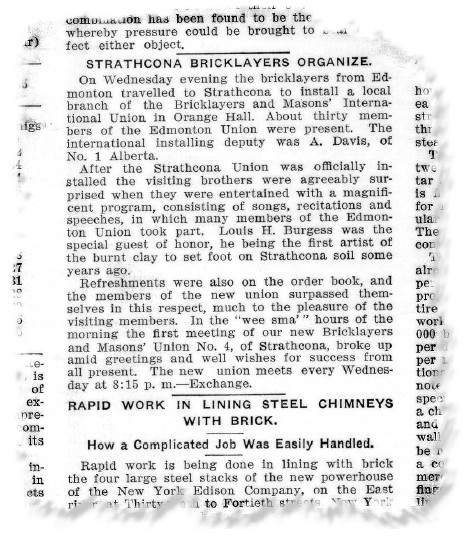
In 1901, twenty years after the first Canadian Locals were
introduced, an elite group of Stonemasons began to organize in
Edmonton. In 1903, R. Leary, R. Spencer, H. Jonston, R. Scott, W.
Allyen, R. Willington and N. Percell came to a decision and applied to
the Bricklayer International Union for a charter in Northern Alberta.
On May 15, 1903 the charter was officially granted and these seven men
became Local #1’s first executive.
With a new beginning and strong leadership our Local began to
flourish. In 1904 the population in Edmonton was 8350 and growing fast.
Unemployed tradesmen from across the country were flocking to Edmonton
and with the population increase came the need for housing and
commercial buildings. At a time when most buildings were made of cut
stone or brick we were at the top of the heap, holding the same kind of
position among the building trades as the Railway Engineers. Our wages
were the highest in the city among the trades, earning $4.00 per day
for a Journeyman and $4.50 per day for Stonecutters.
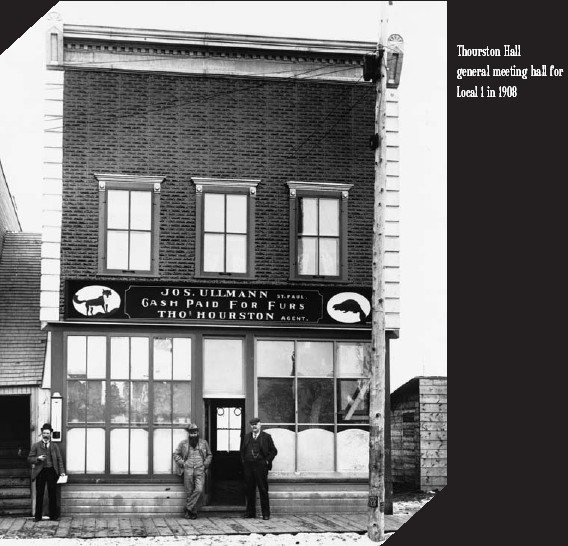 From
1903 to 1913 the boom was on in Edmonton. Such landmarks as the Flat
Iron Building, the Academy at King Edward, the Strathcona Post Office,
and the Legislative Buildings were constructed, making Edmonton the
capital of Alberta. From
1903 to 1913 the boom was on in Edmonton. Such landmarks as the Flat
Iron Building, the Academy at King Edward, the Strathcona Post Office,
and the Legislative Buildings were constructed, making Edmonton the
capital of Alberta.
Work was so good in our region that in 1907 thirty members from
Local #1 traveled across the North Saskatchewan River to install a new
Local, Strathcona Local #4, at Orange Hall.
The membership voted in a new executive in 1908. Frank Blake became
our President, James Brereton, our Vice President, and William Collier
our Financial Secretary. They held their general meetings every fourth
Tuesday at 8:00pm in Thourston Hall.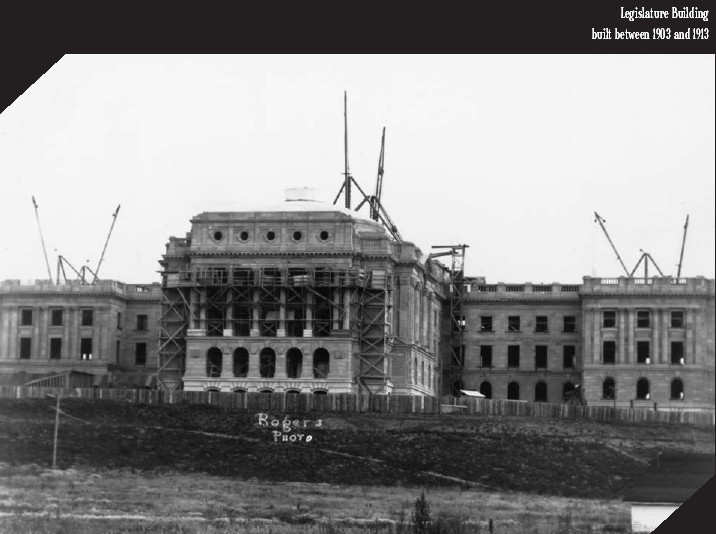
The first record books in our Hall date back to 1912. At this time
Initiation fees were $25.00 for a Journeyman, $5.00 for an Apprentice,
and Local dues were $1.00 per month. By November 1913 our Local hit a
peak of 281 members who were instrumental in negotiating a 48 hour work
week down form the previous 54 hour week.
By 1914 the situation in Europe had an immediate effect on our hall.
World War I was upon us and the financial barons of London decided to
withdraw their capital, bringing construction to a standstill until the
situation stabilized. Many of our members answered to our Country’s
call and our Local made sure they stayed in good standing while praying
for their safe return home.
THE LEAN YEARS (1915 - 1945) 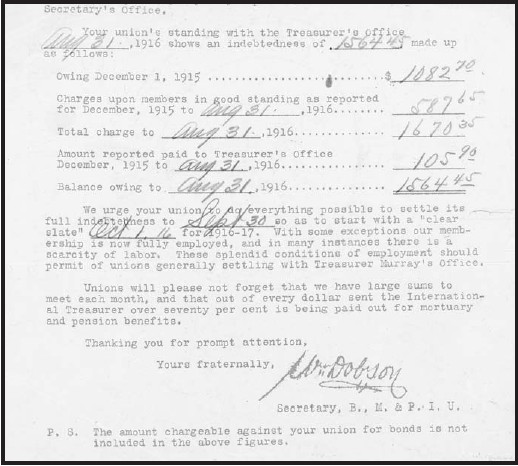
This was a time when our members were off to war and the last major
construction work, the Grand Truck Pacific Railway Building (The
MacDonald Hotel), was near completion. In 1916 our Local was in
financial trouble and owed our International $1564.45. By 1918, dues
rose to $1.35 per month to help combat the situation.
At the end of World War I our members returning home were
disheartened. Construction was at a standstill and our membership had
fallen by three quarters. By 1927 work was beginning to pick up only
to be hit by the 1929 Stock Market Crash and the Great Depression of
the Thirties. The “Dirty Thirties” struck our Local extremely hard and
many of our loyal members found they were unable to maintain their
dues. Our membership declined from 129 Brothers in 1930 to only 10
members by 1937.
Local # 1 owes a debt of gratitude to those 10 members: H. Alying, J
Bawden, S. Bounds, J. Hood, H. Demmark, A. Hunter, W. Smitlen, S.
Parson, J. Wilkins and President at the time Arthur Ball. Without their
loyalty and Trade Union Principles, our Local would not have survived.
Soon World War II was upon us, but it had quite a different effect
on our Local. With a large expansion of services connected with the War
effort and an opportunity for employment, our Local began to grow. The
Initiation Fee was dropped to $15.00 and wages were set at $1.25 per
hour. By 1946 there were 78 members on the books and a 40 hour work
week had been established.
THE COMEBACK YEARS (1946 - PRESENT) Image Links: Image 4
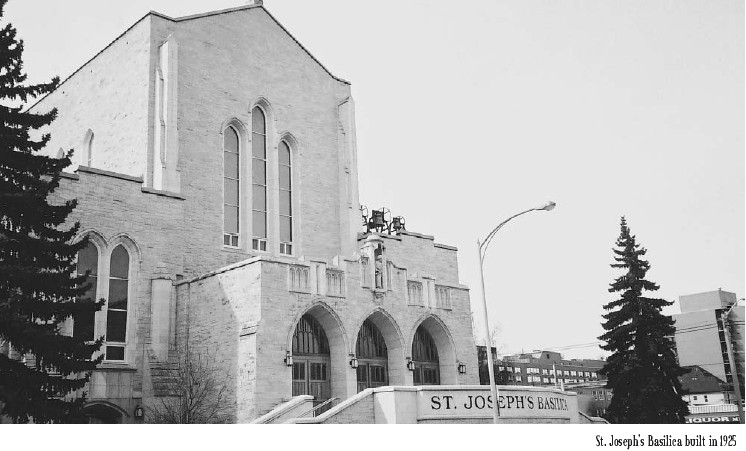 In
1947 Alberta commenced an unprecedented boom. Oil was discovered in
Leduc, and the fall out would change the face of the Local. Not only
would we command the Brick, Block, and Stone work, but a new avenue of
work would become more prevalent – “Refractory Installation”. With Oil
being discovered on a daily basis and the influx of European Tradesmen
flocking to our region, our Local again had a strong footing. By the
1950’s we were not only building such places as Petro Canada, Texaco,
and the first coal-fired generating plants in Wabamum, we were also
constructing a modern city. In
1947 Alberta commenced an unprecedented boom. Oil was discovered in
Leduc, and the fall out would change the face of the Local. Not only
would we command the Brick, Block, and Stone work, but a new avenue of
work would become more prevalent – “Refractory Installation”. With Oil
being discovered on a daily basis and the influx of European Tradesmen
flocking to our region, our Local again had a strong footing. By the
1950’s we were not only building such places as Petro Canada, Texaco,
and the first coal-fired generating plants in Wabamum, we were also
constructing a modern city.
A new breed of Bricklayers was coming on strong. Local #1 hired its
first full time Business Manager, Brother Murdo MacFarland, in 1958. He
later became an instructor and trained our young apprentices. In 1960
Ken Thompson took the helm and remained our Business Manager until
1983. Along his side as our President was Duncan Grant. Together they
directed our Local for 23 years, before they both retired in 1983,
leaving a void in our executive. At this time Gilbert Thomas was
elected as our Business Manager, serving one term and Wally Shaw was
elected as our President, a position that he held until 2003.
Local #1 experienced unprecedented growth up to 1980, when we were
806 members strong. However, a continuous development of three decades
was about to come to an end and would hit Alberta hard. Work was poor
and with a right-wing government in leadership, union busting tactics
were put in place. The “24 Hour Lockout” was in effect and Local #1 was
forced to take a roll back of wages from $18.00 to $12.50. Many of our
good members left the province or attained work in other fields. Local
#1 membership declined to 254 members by 1986. At this point our
members elected Tomas Rowan as the Business Manager.
However this downturn in the economy would not last. By the
mid-nineties a new word hit the airwaves. The Mega Project and Oil
companies again began to build. In 1999 we were able to purchase our
first office building. Alan Ramsay was elected as the Business Manager
in 2001, after the retirement of Tom Rowan, and Brother Malcolm Kane
was hired as the full-time organizer of our Local Hall in 2002. Today, Local #1 sits at almost 800 members province-wide, following the merger in 2014 of Locals #2 and #4 (Tilesetters) into Local #1 Alberta.
Bricklayers Local #1 has seen its
share of hardships over the past 100 years. We remain confident that
the foresight and dedication of our forefathers will not be forgotten,
but will serve as a guide to future generations that are working
towards a better way of life.
|